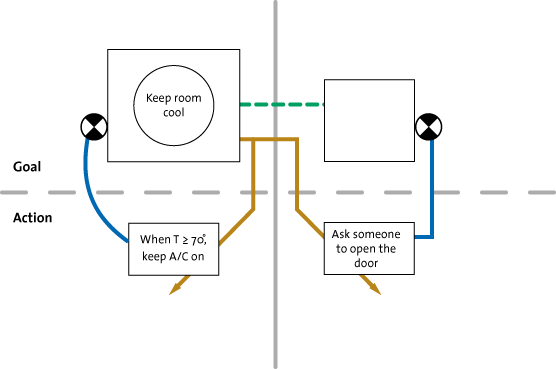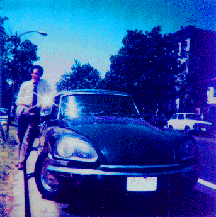Cybernetics — What?
|
I. Lines of Enquiry
These statements suggest how cybernetics could offer perspectives on interaction design:
When a system has a goal, cybernetics offers definitions of "information," "feedback" and "interaction."
When interaction includes a person, cybernetics offers useful models of "personalization," "learning" and "understanding."
When software is in the way of understanding (between person and person, or person and machine), cybernetics may open the flat interface into a semantic space; develop a history of clicks into a relationship; and transform a computer into a partner with a shared goal.

|
It is an enigma to me that goals are not an explicit part of the discussion around user interface design, no less an explicit part of the interface functions themselves. This is not a rant in support of impractical abstractions, but a lament that so many opportunities are lost. It would take some work to connect the "Lines of Enquiry" statements and the model above to interaction design, but for now I offer an anecdote: How many times have you dispatched an email without the attachment that you wanted to send along? Is this your mistake, or the error of the UI designer for failing to allow you to assert your goal and to let you assert it at the moment it was clear in your mind — just as you open a new message. A new menu command, "Send New Message with Attachment", would not let you send a message without an attachment. Even in a simple case, a goal-oriented design process leads to a modest, but I believe useful, insight.
II. Architecture of Interaction

|
III. On-Line References
Materials on cybernetics are only slowly being made available on-line, and these limited references cannot reflect the depth and breadth of the field. And, as in any field with many contributors, not everything under the name of cybernetics is consistent, and some sites may give a confusing impression of cybernetics.
Heinz von Foerster
There are many "giants" of cybernetics, but none so crystal-clear in thinking and writing as Heinz von Foerster.
- "Ethics and Second-Order Cybernetics", an amazing talk about the relationship of goal-directed systems to ethical behavior
- A lovely and illuminating interview with von Foerster
Gordon Pask
Eccentric beyond description and 30 years before his time, Gordon Pask has influenced generations of innovators, including Ted Nelson and Nicholas Negroponte (to name the most well-known figures). Unfortunately very little of Pask's own writing is on-line.
- "A comment on the cybernetic psychology of pleasure" is from the 1960s and only introduces concepts that are developed further elsewhere (see the first Off-Line reference, below). Beware an apparent mislabeling of the 2nd numbered list, which should be 'a,b,c and d' instead of '1,2,3 and 4.'
Personal Links
These links are from my site, which mainly chronicles work from the 1980s and 90s. They introduce ideas related to the Design Summit.
- A definition of cybernetics
- A summary of software
implementations and approaches to user interface design
The remainder of these links are included on the summary page just mentioned:
- A talk given at BayCHI specifically about goal-directed user interface design
- Some polemical remarks about software design
- An aging but still interesting prototype 'search tool'
- Ideas for moving 'Beyond Menus'
- Description of an adaptive hypermedia system based on cybernetics, and how it came about
IV. Off-Line References
This paper describes in detail an interaction environment (that I mentioned at the Design Summit), where the user playing a musical instrument is engaged in a conversation with a mechanism that focuses the user's attention, gets bored, and otherwise stimulates the user in novel and unexpected ways. It is a fabulous proposal for a type of video game, though Pask built the original version of this system in the 1950s and carted it around England in vans for installation in music halls.
- Gordon Pask: "A Comment, a Case History and a Plan". In Cybernetic Serendipity, edited by J. Reichardt. Rapp and Carroll, 1970. Reprinted in Cybernetic Art and Ideas, edited by J. Reichardt. London: Studio Vista, 1971, 76-99.
Special thanks to Hugh Dubberly for asking the first question, and Clarke Robinson for designing the graphics and handout.

© Copyright Paul Pangaro 1999. All Rights Reserved.
